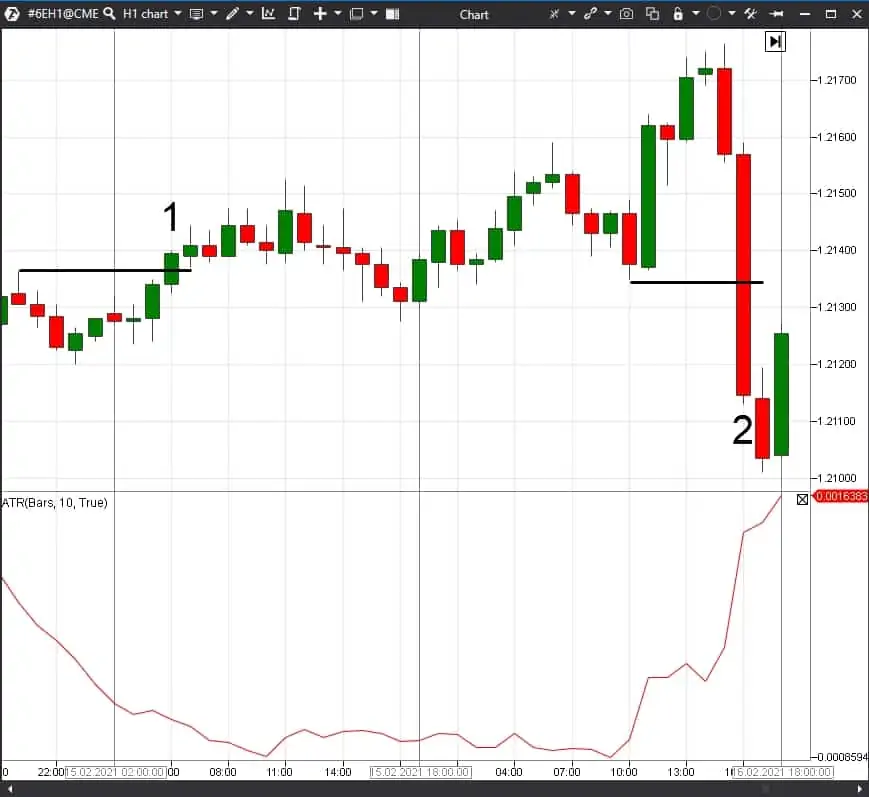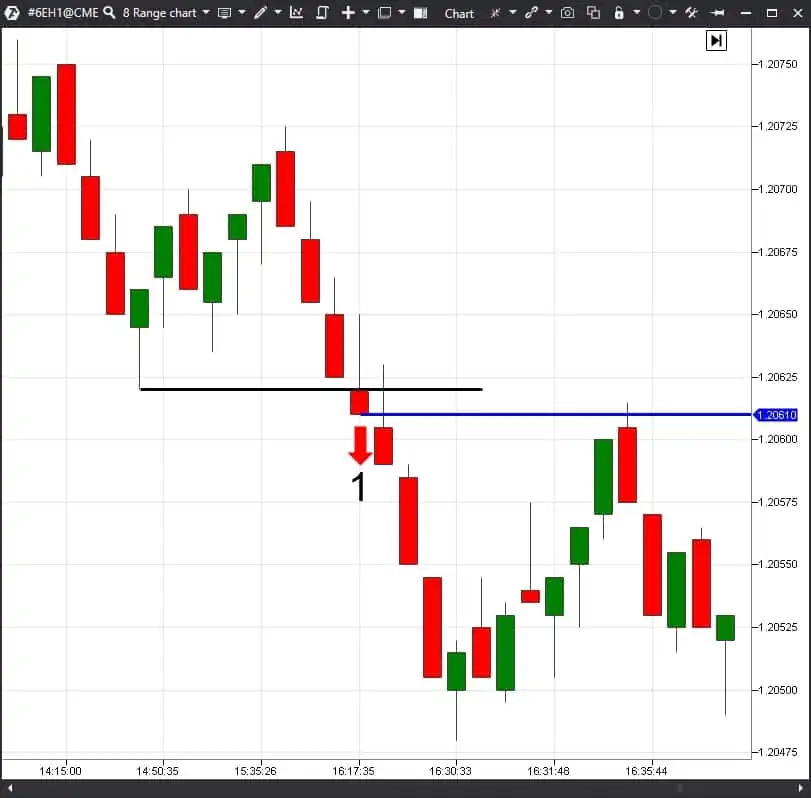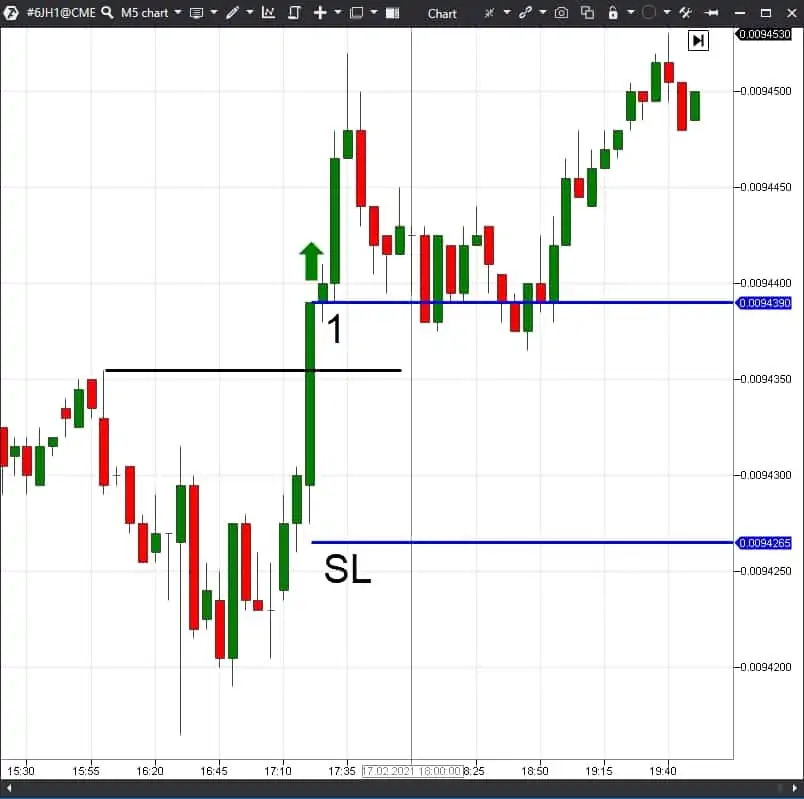Market entry point and stop loss
The majority of traders use classical exchange charts, in which a bar or a candle is built during a certain period of time (time-frame).
Popular time-frames: 1 minute (M1), 5 minutes (M5), 1 hour (H1), 1 day (D) and so on.
Besides, signals for executing trading activity are usually identified after closing the next bar or time period. For example:
- If the hourly bar is closed above the level, a trader will buy.
- If the hourly bar is closed below the level, a trader will sell.
The problem of this approach is that it doesn’t take into account an important market feature – volatility.
Disadvantages of classical time-frames
The market volatility is the price ability to change. Depending on these changes, the difference between the candlestick high and low may differ by several times.
Volatility could be low for several days, then the signal candles will be narrow. Signal candles expand when volatility grows.
Entry points could be close to the levels when volatility is low and will be farther from the levels when volatility is high.
The chart (Euro futures) shows a breakout in point 1. Volatility is low. The candle is small. The level breakout takes place in point 2 at high volatility. The breakout candle is big. And the entry point is far from the level.
The same is true about stop loss sizes. If the trading strategy envisages stop loss posting after the breakout candle, the candlestick size exerts influence on how far it is posted. In the event of wide stop losses under conditions of high volatility, a trader may need even to reduce the trade volume or to refuse from the trade with a far stop loss.
How to solve this problem?
As a variant, to use charts with non-standard periods in trading.
For example, Range.
Finding a market entry point using the Range chart
Building candles in the Range charts is not connected with time. A new candle appears in the chart when the price passes a certain distance in ticks.
This method of chart building allows filtering out the market noise. If the price doesn’t move in a certain direction, new candles will not be formed in the Range chart, while a standard chart may form several small candles and even send some trading signals.
The Range chart allows filtering out false trading signals. This chart is especially useful for intraday trading.
Let’s analyse an example of finding optimum entry points with the help of the Range chart.
First, let’s have a look at the entry point in 5-minute time-frame by the classical breakout trading strategy.
A level breakout took place in point 1. However, the breakout candle is in the form of a hammer with a long shadow. Will the movement continue? It is not clear. Most probably, a trader should have waited for one more candle for the signal confirmation. The second candle after the breakout is a trend one (point 2). A breakout took place and it is possible to enter into a short. The entry point is at the price of 1.20505.
Let’s consider the same market section but using the 8 Range chart:
The level is broken in point 1. The breakout takes place earlier than in the 5-minute chart. It happens due to the method of candle building. And, correspondingly, the point of entry into a short is better – the price is 1.2061
Of course, such a big difference in entry points doesn’t always take place. But very often the Range chart allows entering at a better price than the classical time-frame chart. Especially big difference takes place when volatility increases in the market.
Posting a stop loss with the help of the Range chart
Finding the right place for posting a stop loss is very important for profitable trading. A too close stop loss will be often activated by the market. A too far stop loss increases the risk and also makes the reward to risk ratio worse. How to solve the problem?
The Range chart will help you. A trader can use it for finding the most optimum place for a stop loss:
- relatively close to the entry point;
- so that the market doesn’t activate it too often.
Let’s consider an example.
The stop loss location in the 5-minute chart:
The level of a wide volatile candle is broken in point 1. A stop loss could be posted after the candle low. A stop loss is rather big with this approach.
Let’s consider the same market section in the 8 Range chart.
The level is also broken in point 1. However, the breakout candle is much smaller. The stop loss, which is located after the breakout candle low, is also smaller.
Thus, the Range chart allows finding more optimum places for posting stop losses. The difference is especially big when the market volatility increases.
You can select individual Range chart parameters, which would allow more efficient trading, for every instrument. The more volatile the instrument, the bigger the Range chart parameter should be.
Conclusions. What to do in practice?
So, it is important to understand that:
- The charts built on time periods do not take into account the changing market volatility.
- The Range charts from the trading ATAS platform could be used to take into account volatility.
- The Range chart allows finding a more accurate entry point when the market volatility increases.
- The Range chart allows decreasing the distance of stop loss posting.
- Simultaneous use of classical charts together with Range charts can increase trading efficiency.
Look at the market from different angles and it will help you to stay on the positive side!
You can find more useful information in the following articles:
Information in this article cannot be perceived as a call for investing or buying/selling of any asset on the exchange. All situations, discussed in the article, are provided with the purpose of getting acquainted with the functionality and advantages of the ATAS platform.








